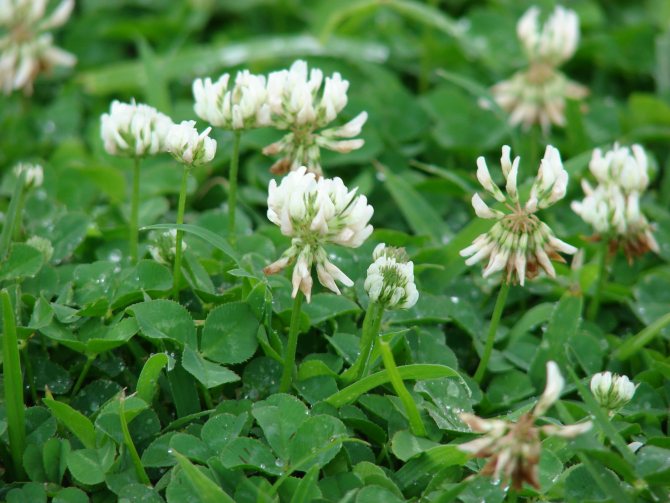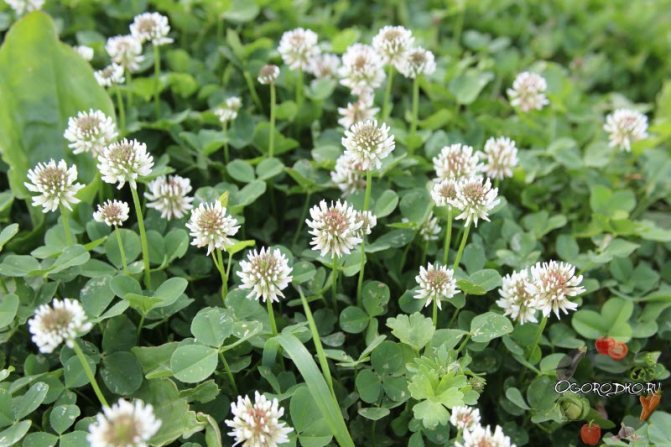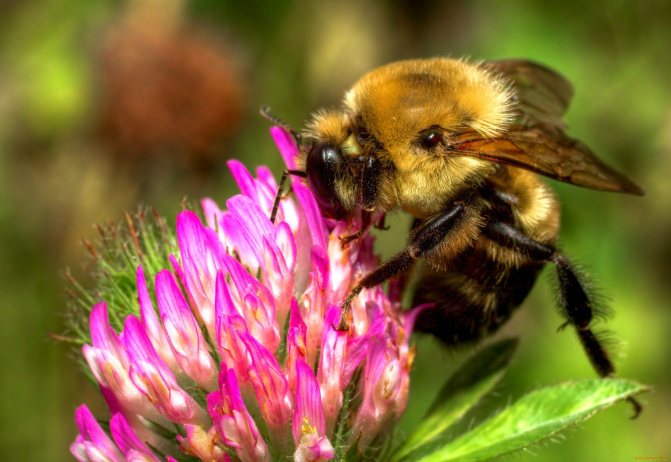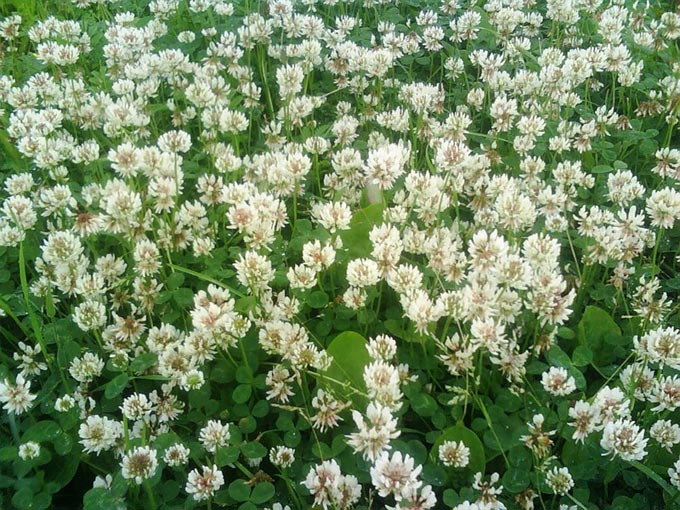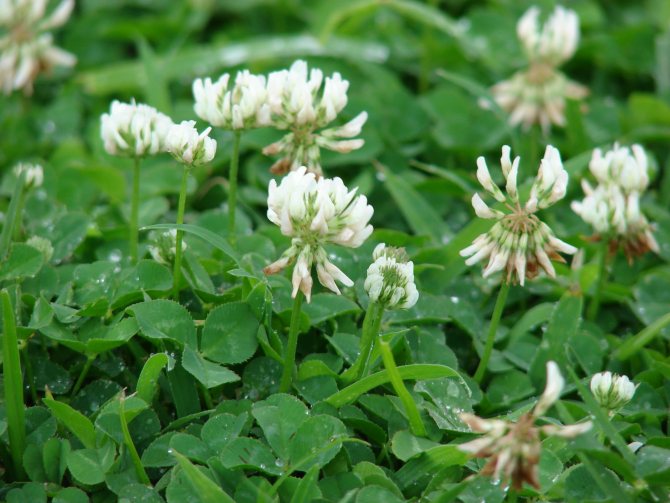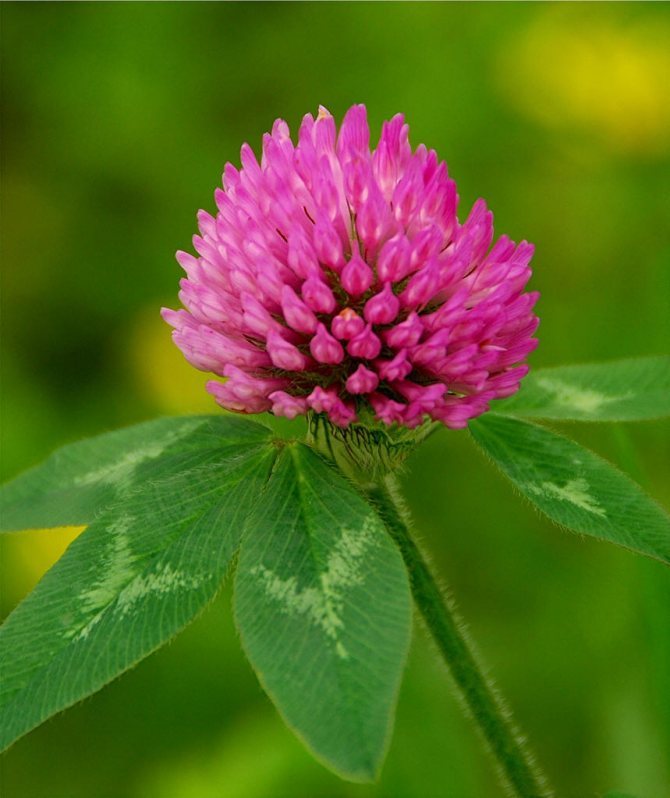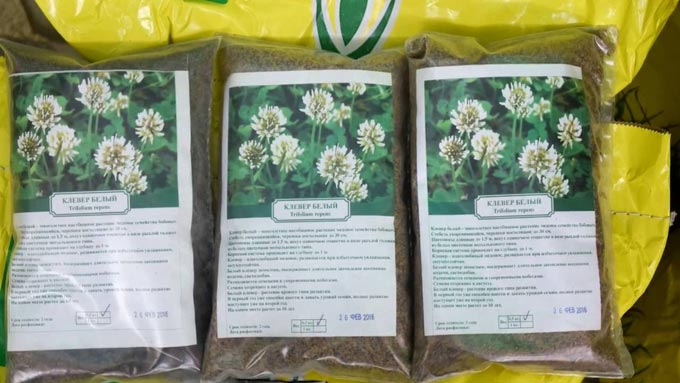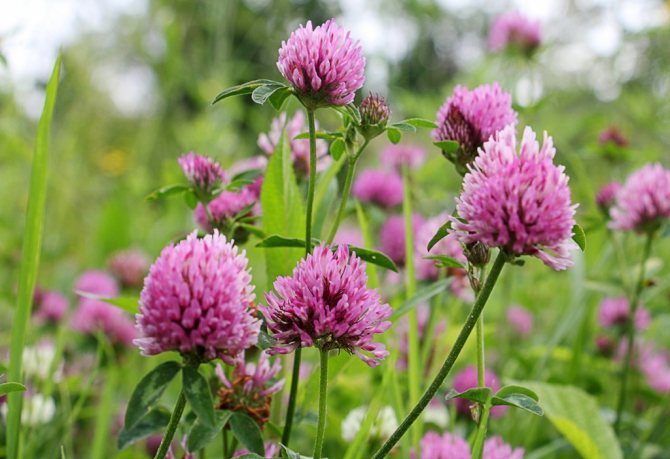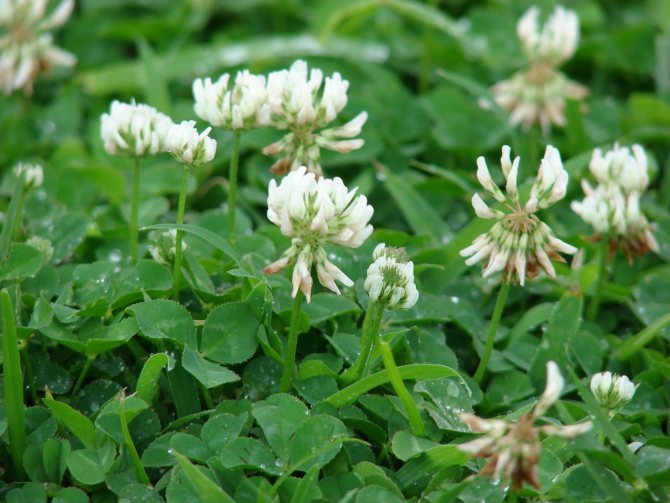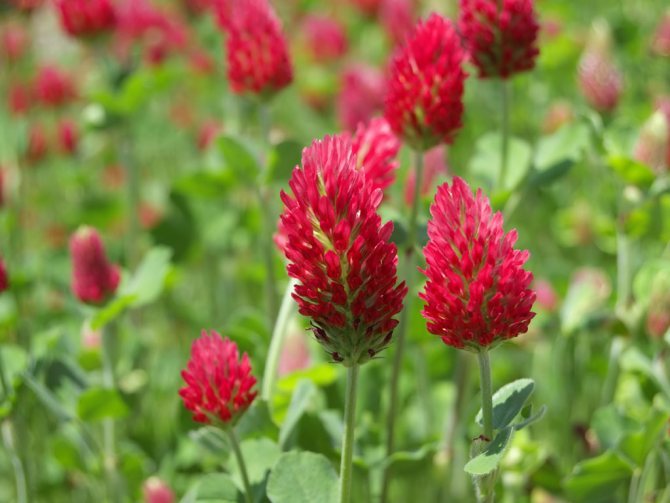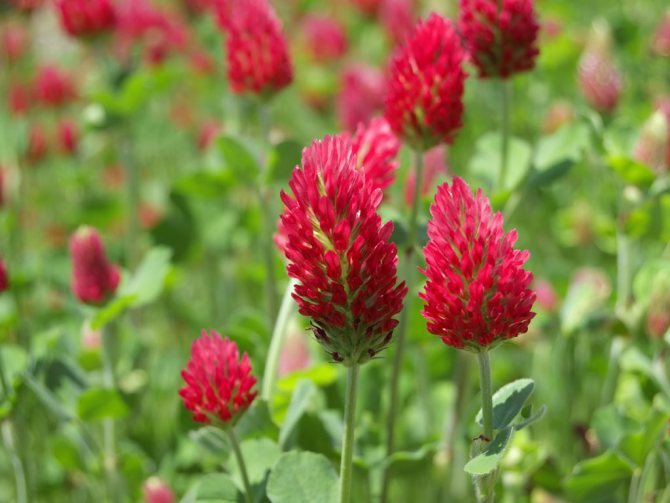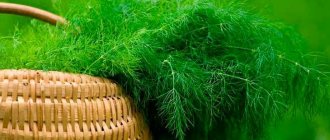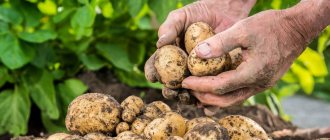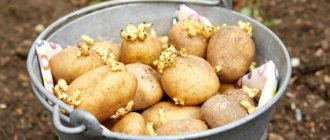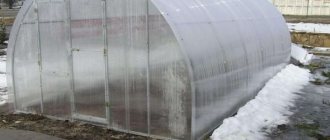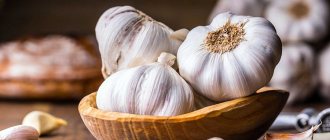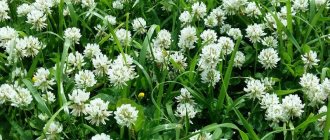Clover agrotechnology
For red clover, humus nutrient soils with low acidity are preferable. The plant does not tolerate saline and sandy soils. The earth should be moderately moist, without stagnation.
Pink clover is not so picky and grows well on structured loamy and sandy loam soils. It tolerates acidic substances more easily than other varieties.
White clover is the most unpretentious, grows calmly on peat bog, alumina, if only there is good drainage and sufficient moisture.
Clover does not belong to drought-resistant crops, cold-hardy, but winter hardiness is low. May also be affected by summer heat. It is considered relatively shade-tolerant.
Site preparation
If the precursors of the shamrock on the site were cereals, this will have a positive effect on growth. It is advisable to grow the grass in spacious areas. Clover will look good in areas of the garden with a small shadow; they can sow empty places near a building, a fence.
Having decided on the location of the lawn, you need to prepare the soil in order to sow clover.
Important! Preparing the soil with a cultivator or Fokin flat cutter is considered the most optimal way.
The selected area must be dug onto the floor with a bayonet, then loosened up the ground and select all the roots of weeds, stones, debris. At the same time, phosphorus and potash fertilizers are applied, the acidic soil is lime.
Important! It is not necessary to apply nitrogen fertilizers under the clover, since it produces nitrogen itself. An overdose will kill the herb.
Before sowing clover on the site, the land must be allowed time to settle. Usually it is 4-5 days.
You should know that it is advisable to grow a red variety for no more than 3 years, pink - 8 years, and white can please the eye for almost 19 years.
Planting clover
The culture propagates by seeds, which are harvested in the second year of life. Also, the finished material is purchased in stores. Sometimes the grass is propagated by dividing large bushes, but they have poor survival rate.
When to sow clover in spring, you need to determine the average daily weather. It should not be lower than 10 ° C. Usually, spring sowing is carried out at the end of April.
When you can plant clover in the fall, you need to calculate the time so that the shoots rise by 8-10 centimeters before the first frost.
Deciding when to plant clover, in fall or spring, should be based on your goals and the benefits of seasonal planting. For laying a perennial lawn, it is better to sow the grass in the spring:
- will grow with prolonged spring;
- having a creeping stem, will quickly cover the lawn;
- flowering will attract insects to pollinate all horticultural crops;
- periodically mowing will allow you to prepare food for the animals of the courtyard.
Before sowing clover, the plot is divided into sections so that sowing can be done without gaps. It will also allow you to calculate the required number of seeds. For 1m², about 300 seeds (10 g) are needed.
Before planting the clover, the soil is well moistened, and when the top layer shakes out a little, the seeds are sown with a seeder or on their own.
For even sowing by hand, the seeds are best mixed with river sand.
For even sowing by hand, the seeds are best mixed with river sand.The seeding depth is approximately 1.5 cm, on light soil, up to 3 cm is allowed. It is advisable to use seeds from stores: there they are already scarified and treated with nodule bacteria.
Experts recommend rolling the lawn after planting. To do this, you can use a roller, barrel, smooth log. Watering is carried out with rain nozzles so as not to wash out crops. After a couple of weeks, shoots can be expected. The shamrock grows slowly, moreover, it does not drown out weeds and they are actively developing. Annual cereals will help to cope with weeds: before planting clover, their seeds are mixed. With the beginning of active clover growth, cereals are mowed. This option is used if you have to grow a crop in large areas.
Home-grown, small lawns can be weeded, so a cover of cereals is not needed.
Important! You need to trim the grass with a trimmer: it adjusts the height, does not clog, and is easy to clean.
If the grass was not grown for greening and is left to winter, then you need to know when to mow red clover for the first time. This procedure is carried out when the plant reaches a height of 15 cm, before flowering, but no later than August.
Clover care
Taking care of your shamrock lawn is easy and effortless. All care is watering, aeration, feeding, removal of emerging weeds.
Clover blooms twice: in June, in August. Most of the hassle is between these events. Mow the lawn, remove dried stems and flower heads.
Watering
Watering is the main condition for the normal development of culture. Any variety of clover is demanding on moisture, does not tolerate drought well. The greatest need for water in a plant occurs in the first year, especially if it grows under the cover of another crop. Lack of moisture leads to the death of shoots, and the undeveloped superficial root system can freeze out in the winter cold.
The trefoil that receives a sufficient amount of moisture, due to its enhanced development, accumulates a sufficient supply of nutrients in the root collar and winters better.
Clover water consumption increases in direct proportion to the growth of greenery, and sharply decreases after cutting. However, with a lack of moisture after cutting the green mass, thinning of the grass stand, the appearance of bald spots may occur.
Clover neighbors
The least suppression of the trefoil occurs with Timothy Meadow, therefore it is recognized as the best component. Meadow Fescue adjoins well with clover. The rest of the grasses partially inhibit clover shoots.
Fertilization and feeding
In order for clover to grow and develop normally, it should be provided with quite a lot of calcium, potassium, phosphorus, micro and macro elements:
- during autumn digging, manure is introduced. It is the autumn introduction of organic matter that significantly improves the herbage;
- before sowing, they must enrich the land with potassium and phosphorus;
- podzolic soils are flavored with boron. Trefoil processing is also carried out at the beginning of flowering.
The plant also needs trace elements such as copper, molybdenum, but in small quantities. Throughout its life, clover has a different need for nutrition, which changes depending on the dynamics of the growth of greenery. So the need for phosphorus increases during the onset of growth and during regrowth periods after a haircut.
Clover responds well to early spring feeding with potash fertilizers. They can be scattered over a small area.
Use in the garden
| Tomatoes | Cucumbers | Pepper | Zucchini | Cabbage | Onion | Garlic | Beet | Turnip | Potatoes | Carrot | Peas | Beans | Strawberry | Fruit trees | Raspberries |
| Red clover | + | + | – | – | – | ||||||||||
| Clover pink | + | + | – | – | – | ||||||||||
| White clover | + | + | – | – | – | ||||||||||
| Vika spring | + | + | + | + | + | + | – | + | – | – | + | ||||
| White sweet clover | + | – | – | – | + | ||||||||||
| Melilot yellow | + | – | – | – | + | ||||||||||
| Perennial lupine | + | + | – | – | + | – | – | ||||||||
| Lupine angustifolia (blue, annual) | + | + | + | + | + | – | – | + | – | – | + | + | |||
| Lupine yellow (white) | + | + | + | + | + | – | + | – | – | + | + | ||||
| Alfalfa | + | + | + | + | + | + | – | + | – | – | + | ||||
| Seradella | + | + | + | + | + | + | – | – | – | ||||||
| Broad beans | + | + | + | + | – | – | – | ||||||||
| Peas and dumplings | + | + | + | + | – | + | – | – | |||||||
| Eastern galega (goat's rue) | – | – | – | ||||||||||||
| Winter rape | + | + | + | + | – | + | – | – | + | + | |||||
| Spring rape | + | + | + | + | – | + | – | – | + | + | + | ||||
| Winter rape | + | + | + | + | – | + | – | + | + | + | |||||
| Oil radish | + | + | + | + | – | + | – | +* | + | + | |||||
| Mustard white | + | + | + | + | – | + | + | + | +** | + | + | + | + | ||
| Winter rye | + | – | +** | + | |||||||||||
| Annual ryegrass | + | – | + | ||||||||||||
| Oats | + | + | + | – | + | ||||||||||
| Buckwheat | + | – | + | ||||||||||||
| Phacelia | + | + | + | + | + | + | + | + | + |
Note:
* - increases productivity by 1.5 times, but common pests.
** - protection against wireworm.
In summer cottages, when sowing siderates, the same agrotechnical practices should be observed as for vegetable crops. It is advisable to sow in grooves in moistened soil, not very often (so that there is a place for the root system and green mass to develop), be sure to sprinkle it with earth (so that birds do not peck). In the spring, dried spring green manures, which have been sown in the fall, are harvested with a fan rake and used as mulch. Then the main vegetable crops are sown or planted on the finished bed. In order for the powerful root system of winter green manure (for example, rye) to overheat faster, use the biological product "Shining-1" (Japan) and cover it with black film for 2 weeks.
To neutralize acidic soils, winter rye, oats and other cereals are sown. Winter rye also drains wet areas.
It should be borne in mind that on different soils and under different climatic conditions siderates can manifest themselves in different ways, so do not be afraid to experiment, use mixtures (classic example: oats + vetch) and select those that will be the best helpers in improving and enriching the soil precisely on Your site.
Summer residents who are just starting to use green manure in their area sow small plants, for example, white mustard. An annual crop, it tolerates cold well, is suitable for many cultivated plants, is used in the fight against wireworms, weeds, disinfects the soil, is easy to use. Mustard seeds are almost always available from specialized stores.
How to care for a plant in the fall, preparing for winter
To keep the summer cottage without a lawn, you need to save the lawn for the next season. To this end, it is necessary to carry out proper autumn care and prepare the clover for winter. Autumn work includes mandatory activities:
- watering, haircut;
- aeration and feeding;
- foliage cleaning and restoration.
Each process has its own deadlines and nuances. If all autumn work is carried out carefully, then the open clover lawn will staunchly meet frosts and will endure hibernation.
Autumn care
In the fall, the grass cover begins to dry out a little, and with the first cold snap - and freeze. Therefore, the first priority is to strengthen the root system. For this, the irrigation regime should be adjusted.
Seasonal rains allow the plant to extract moisture naturally. The last watering, in the absence of rain, is carried out no later than the first days of October. Further irrigation is not done to prevent waterlogging of the earth, as a result of which the roots of the grass can weaken and die.
Since the summer mowing of the lawn has severely depleted the soil, it is necessary to apply potash-phosphorus fertilizers. Otherwise, the lawn will become very thin and faded.
To prepare the grass for overwintering, you should apply special complex fertilizers. They reduce growth processes, intensively nourish the roots. The best option is diammophoska.
In the autumn period, diammofoska is used within 2 kg per one hundred square meters of lawn. Potassium reduces the accumulation of moisture in the roots, increases disease resistance. The all-round action of the element prevents cellular damage to the herb by ice microcrystals.
Ash and bone meal contain a very large supply of nutrients. They are crushed to strengthen the roots only until mid-October. If the season is dry, the lawn should be lightly watered.
Aeration
A prerequisite for the autumn care of the shamrock lawn is the aeration of the earth. By piercing the soil, many useful and necessary tasks are performed:
- water will not accumulate on the surface, forming puddles and ice crusts, but will penetrate deep into the earth;
- during the summer months, the soil becomes very compacted, as a result of which the supply of nutrition to the roots becomes more difficult. Aeration promotes loosening and good oxygen supply;
- due to the low thermal conductivity of the air, the soil freezes less and the roots of plants will not die.
- the aeration technology is carried out in two ways: using an aerator with hollow teeth, and metal pins, for example, a pitchfork.
Note! The time for aeration is September-October, the soil should be slightly moistened. The procedure is carried out before the autumn feeding, after which they do not walk around the site for 2-3 days.
Lawn mowing
In regions with a harsh climate, many summer residents are wondering about the winter mowing of grass. There is only one argument - the winter is cold, the roots under the foliage will be protected. However, experts insist on a mandatory haircut for several reasons:
- the load on the roots will decrease due to low nutrition;
- young roots will have the opportunity to prepare for the first frost;
- under the snow, long stems will die off and form a felt, which attracts rodents, pests, pathogenic microorganisms.
Important! The health and further condition of the grass depends on the correct and timely cutting. Cutting too early will cause the grass to rise quickly and prevent the roots from preparing for the cold. If you are late with a haircut, the lawn will die out.
The last haircut in different regions is carried out depending on the weather conditions. The optimal time is 2 weeks before frost.
It is important to use a trimmer when trimming clover in the fall. It can be set to the required height - 5 cm. This is sufficient height and the stems will have time to recover.
It is important to use a trimmer when trimming clover in the fall.
Before the procedure, the fallen leaves are cleaned. If this is not done, the leaves will inevitably sprout and there will be bald spots on the lawn in the spring. On alumina, the shearing is accompanied by drainage. All mowed grass must be harvested.
Lawn shelter
You need to decide on the shelter of the lawn for the winter - if the winters are severe enough, then it is advisable to cover the site with a cover. In warmer winters, additional shelter is not required.
With proper preparation in the pre-winter period, the clover will tolerate the cold quite calmly. In winter, the lawn does not need special care. It's enough just to adhere to some recommendations:
- it is not necessary to remove the fallen snow, it is enough just to clear the paths;
- it is highly undesirable to walk on the lawn if the snow is of a small thickness;
- if a dense crust of ice appears on the lawn after thaws, it must be broken with a garden rake, providing air for the plants.
Such simple measures will prevent clover from freezing and damping out. The shamrock will survive well until spring.
https://youtu.be/Gs7HUzb91vE
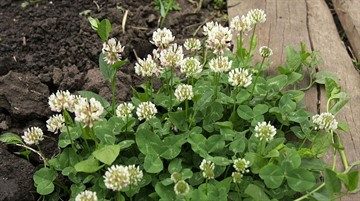
Among the huge variety of plants, only a few are recognized as suitable for arranging a lawn - a bright green tender grass carpet with a dense sod resistant to mechanical stress. This includes white clover, also known as "curly honey plant" or "white gruel".
The article below is devoted to the peculiarities of this plant, the topic of which is creeping white clover: planting and care.
Place in the crop rotation
Clover of any kind is a successful predecessor for almost all horticultural and horticultural crops. Berries, tomatoes, peppers, eggplants after it are sweet and aromatic, cucumbers - juicy and crispy, root vegetables and potato tubers - even and smooth. In areas where clover grew, cabbage, onions, garlic, lettuce and herbs thrive and bear fruit. The only exceptions are plants of the legume family.According to the basic requirement of crop rotation, peanuts, beans, beans, peas, chickpeas, soybeans, lentils are sown after a related green manure no earlier than 3-4 years later.
It is common to use pink and white clover to cover the soil in irrigated orchards. Fruit and berry crops from such a neighborhood get the maximum benefit: the dense sod of green manure retains moisture in the near-trunk circles, and the roots of the plant continuously supply trees and shrubs with nutrients throughout the season.
Clover: varieties and varieties
The plant belongs to the legume family. There are more than 300 types of clover, of which about 70 grow on the territory of the post-Soviet states.
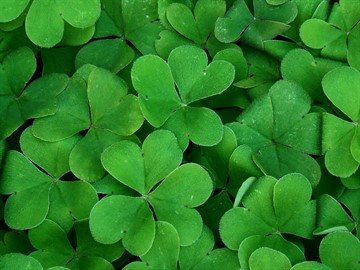

Here are some examples of clover:
The last three varieties are the most common. Types of clover differ from each other not only in the color of the flowers, but also, for example, in the structure of the root system.
So, red clover takes root to a depth of 2 m (high resistance to drought and cold), while white - only 35 cm. There are other distinctive features, including the color of the leaves. Before planting, it is recommended to study the list of species and varieties in order to choose the most suitable for your site.
To date, breeders have bred many varieties of white creeping clover, for example:
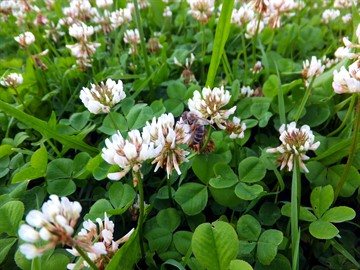

The last two varieties were bred in Belarus.
Clover is great for growing lawns due to the following qualities:
- aesthetic appeal: dense grass of a juicy green color, blooming twice a year with fragrant and beautiful white buds in the shape of a ball;
- gentle, soft shoots: it is pleasant to walk barefoot on the lawn;
- resistance to trampling: outdoor games on the lawn do not harm it.
In grass mixtures, clover supports cereals well, especially ryegrass. With such a neighborhood, they grow better and the lawn acquires a rich color.
The popularity of the plant is due to other advantages:


- vitality. Clover grows well on any soil, both in illuminated areas and in moderately shaded areas. It tolerates a lack of moisture and does not need feeding. For a novice gardener, this is the best option;
- dense and strong root system that holds the soil together. This makes the clover suitable for planting in steep slopes;
- low cost. Clover seeds are available for self-picking. Moreover, they have good germination;
- suitability for consumption by pets and poultry;
- the ability to improve the soil. The roots of clover are home to bacteria that enrich the soil with nitrogen. Vegetables planted after clover give a rich harvest.
How to sow clover on the site
Clover is an excellent honey plant. It is sown because it forms a dense, beautiful groundcover. It is a unique forage crop for animals. It is considered a green manure that enriches the soil of a vegetable garden or garden, organic matter and nitrogen. The agricultural technology of growing clover is not very complicated. It is just enough to water and loosen the soil in time. To plant clover, you must have: a shovel, soil, fertilizer, seeds, water and a watering can.
Recommendations for planting clover at their summer cottage
Initially, you need to prepare the ground. Clover is an unpretentious plant, but it grows best in areas where there is a lot of sunlight, and then it gives a beautiful carpet of flowers and greenery on loose, organic soil. It is better to apply fertilizers to the soil in the fall, when the earth is dug up in the vegetable garden or garden. Together with the manure, you need to add seven grams of double superphosphate and five grams of potash fertilizers.
In early spring, before the green shoots of clover grow back, you need to add five grams of urea. It is recommended to scatter the granules on the soil surface.
For sowing clover, it is advisable to choose a warm autumn day. It is desirable that the atmospheric temperature does not rise more than 15 degrees Celsius, otherwise the clover will grow and die from the cold.Since the seeds of clover are very small, they must be mixed with fine river sand (1: 3) and sown in grooves, at a distance of ten centimeters from each other. Also, you can sow this plant randomly, but in this case, more seeds will be needed.
It is advisable to feed the soil with a liquid manure mixture.
This should be done in early spring, when the temperature will not drop below seven degrees Celsius and new shoots will start to grow. To prepare the fertilizer, you need to dilute 15 kilograms of mullein in 30 liters of water, cover with plastic wrap, tie it so that oxygen does not pass through, leave for 6-7 days. After a while, you need to remove the film, mix the fertilizer, dilute with water (1: 5) and feed the young shoots.
The plot should be sprayed with Intavir solution or treated with another insect repellent. This should be done when the plant enters the budding period. For pinkish-red flowers and greenery to please the eye for as long as possible, you need to feed the clover with wood ash. It contains magnesium, potassium and many other useful substances that help improve vegetation, and also protect clover flowers from various diseases.
No comments yet!
Planting white clover outdoors
Planting clover is planned for the spring, when the average daily temperature reaches +10 - +13 0 C. Most often it is April - May. You can plant the plant in the fall, but before November: the shoots should have time to grow to a height of 7-10 cm before the first frost. In the fall, they grow more slowly, therefore, it is important to choose the planting time with a sufficient margin.


The clover is planted in this order:
- prepare the soil: dig it up with the simultaneous removal of plant roots or loosen it
- if the weather is dry, the area is watered abundantly a day before planting;
- immediately before planting, the seeds are soaked for an hour in warm water;
- Spread the seeds evenly over the area so that the grass carpet is thick and uniform. The optimal consumption is 500 g per hundred square meters or 320 pieces. per sq. m. If the planting material was purchased in a store, the area for which it is designed is indicated on the package.
Clover seeds are dark in color, so it is difficult to determine how evenly distributed they are. To better navigate, the beans are mixed with sand before planting. The seeds are sprinkled with earth in a layer no thicker than 2 cm.
They also resort to mulching with a thin layer of peat. Then the surface is rolled with a garden roller. This prevents weathering and leaching of the kernels, makes them less accessible to birds and improves contact with the soil. Seedlings appear in about 14 days.
Plant care
Clover, like a wild-growing herb, feels great without leaving. But in order for the lawn to look attractive, you still need to do something.
Watering
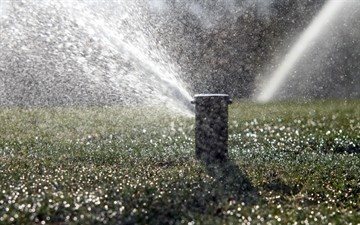

If the weather is not dry, the clover completely manages the rain moisture. Therefore, watering is usually required relatively rarely - once every 7 days or generally from case to case. In drought, water is supplied more often.
Clover, especially red clover, does not like stagnant water - in such conditions it is affected by a fungus, therefore it is required:
- choose places for planting clover where flooding does not occur;
- level the area before planting the seeds: if it is bumpy, water accumulates in the lowlands;
- on heavy clay soil: lay a crushed stone and sand drainage pad under the fertile layer.
Water should be supplied in sufficient quantity, but not in excessive quantity.
Weeding and removing dried flowers


Allowed only by hand: clover does not tolerate chemical treatment. It is important to uproot perennial weeds, otherwise they will germinate again soon. It is best to do this after rain, when the ground is soft.
They stay on the stem and make the lawn look unattractive and brown.
Clover is a perennial plant; accordingly, it begins to bloom from the second year of life.
A haircut
It is recommended not to run a clover lawn: as already mentioned, high thickets are actively populated by snails and slugs, which bring death to all cultivated plants in the vicinity. It is important to mow the lawn after the first flowering (early summer), thereby removing dead wood. This will give your lawn a neat look and intensify flowering.


Trimming destroys the color of the weeds, preventing them from multiplying in this way. For clover, which does not allow chemical treatment with herbicides, this is especially important.
Moreover, if the lawn has a large area. Shearing also prevents the spread of the clover itself, which is important for nearby plants with a weak root system.
Plant propagation
Clover reproduces in two ways:
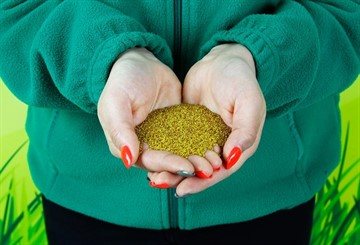

- through seeds;
- vegetatively: lets out rooting shoots, which is why it is called creeping.
The seeds are easy to pick by yourself:
- pluck the largest withered flowers;
- peel seeds;
- dried in a warm, dry place, protected from direct sunlight;
- placed in a box or cloth bag for storage.
Diseases and pests
When waterlogged, clover suffers from the development of a fungus, most often the following diseases occur:
- fusarium (fungi from the genus Fusarium Link);
- rust (causative agent - fungus Uromyces trifolii-repentis Liro);
- anthracnose (mushroom Aureobasidium pullulans);
- ascochytosis (Ascochyta trifolii Bond mushroom);
- brown spot of clover (marsupial mushroom Pseudopeziza trifolii Fckl).
The fight against fungal diseases consists in treatment with a 1% solution of colloidal sulfur. Sprayed twice: when the first signs of the disease appear and then after 8-10 days.
Pollination with ground sulfur or fluff lime is also used. Clover can also be affected by the parasitic flowering plant dodder. It is devoid of leaves and roots and exists only at the expense of the host plant.
If clover is used for livestock feed, active measures must be taken to eliminate the dodder, as it is poisonous and can even kill animals.


Hay with the presence of such grass quickly grows moldy, therefore, after mowing, the clover is cleaned of the parasite. And even in this case, give the animals with caution - with a break of 10-15 days.
When dodders are found, it is important to mow the clover before the parasite begins to bloom. Mowing is carried out on an area exceeding the size of the hearth by 1.5 m in each direction. The cut grass is burned outside the lawn. Another pest is a cyst nematode.
White creeping clover in landscape design


Clover is suitable not only for arranging a lawn, but also for filling the gaps between buildings, trees, creating living borders along the paths.
This will improve the soil, and it will take less effort to maintain the well-groomed appearance of the site - clover displaces most of the weeds on its own.
This plant is well suited for the design of playgrounds for sports or children's games - due to its resistance to trampling. Thanks to its strong root system, the plant is excellent for upgrading slopes: dense turf keeps the soil from crumbling and destruction. Clover looks especially good in its pure form in large areas.
Related Videos
On the pros and cons of a white clover lawn in the video:
White creeping clover is a wonderful ornamental plant that, moreover, has fodder properties. The main disadvantage of the plant - the active attraction of bees - is easy to fight: it is enough to remove flowers in a timely manner by mowing. Therefore, it can be argued that the advantages of clover are superior in importance to its disadvantages.
- 1 Planting clover
- 2 Clover care
- 3 Types and varieties of clover
- 3.1 Creeping clover varieties loved by gardeners and landscape designers
Clover is very common in Russia. Whole pastures and meadows were sown with clover in order to prepare them for animal feed.But there are many ornamental types of clover that are planted on lawns, lawns, alpine slides and rockeries.
In Latin, clover is called Trifolium - "shamrock". And the leaf with four plates, which occasionally comes across in the trefoil species of clover, is considered a symbol of good luck. However, there are types of clover in which all the leaves are quadruple. The clover leaf is the emblem and national symbol of Ireland, and in Russia it is considered a symbol of the Trinity.
On our site, this culture grows wild. Clover is very fond of our rabbit, but this plant is useful not only for a rabbit. The soil receives nitrogen from it, which is accumulated in the nodules on the clover roots by special bacteria.
Clover belongs to the legume family, its flowers are small, in the form of a round fluffy head of yellow, pink, white, red colors.
Application
Due to its rich chemical composition and healing properties, clover is used in folk medicine, cosmetology, and cooking.


Healing properties
Clover honey is a powerful medicine against many diseases.
Prepare from flowers:
- infusions;
- medicinal tea;
- decoctions.
The flowers of the grass, the leaves contain:
- vitamins of the B-group, as well as E, C, K;
- minerals: potassium, phosphorus, selenium, calcium, iron;
- essential oils;
- phytoestrogens;
- flavonoids;
- salicylic and other organic acids.
Clover is an antiseptic, antiviral, diuretic, choleretic. Lowers blood sugar, cholesterol, calms the nervous system, fights fungus, heals female diseases, cleanses the blood, lymph, removes toxic substances from the body.


Clover honey
Bees extract nectar from the flowers of the plant. This is clover honey. It cannot be without admixtures of other herbs. Because it is impossible for bees to tell which plants to plant on, where they cannot.
Clover honey is light with an amber hue, floral aroma. If nectar is harvested from red flowers, the product turns yellow-pink. Honey is sweet, does not taste bitter. Fresh product is not liquid, but flows easily, over time (over several weeks) thickens.
Used to treat tonsillitis, inflammation, cough, colds. Restores immunity, calms the nerves. Clover honey is especially useful for the female body, it is not for nothing that it is called ladies'. Helps maintain female youth and beauty.


Contraindications
There are restrictions on the use of clover preparations. It is forbidden to use in certain conditions:
- pregnant women;
- under reduced pressure;
- with rapid blood clotting;
- oncological diseases of female organs.
If a person has suffered a heart attack, stroke, do not treat drugs with clover. Before being treated with clover, you need to consult a doctor.
ethnoscience
In the field of traditional medicine, clover is widely used. Means made from the plant are used both for the treatment and prevention of diseases:
- Tea brewed with clover improves immunity, relieves insomnia, relieves nervousness.
- Clover honey treats colds. It is also used instead of sugar, since it is not as high in calories.
- Flower tinctures help with high blood pressure, headaches. Tinctures are prepared both with water and with vodka.
- Decoctions reduce sugar, cholesterol. Treat colds.
- Clover ointments help with skin diseases, heal wounds, burns.
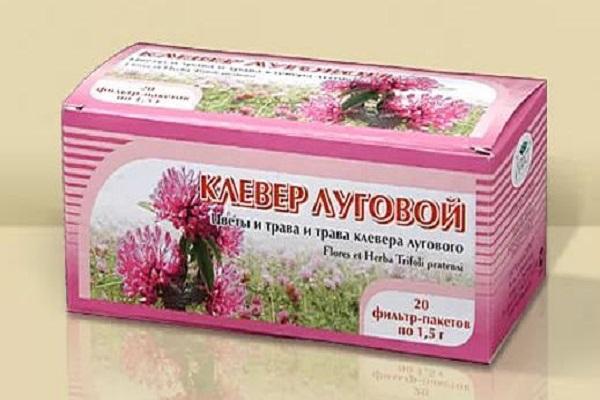

Fodder crop
Clover is high in protein and therefore nutritious. It contains all the necessary elements needed for winter feeding of cattle.
The varieties bred specifically for livestock feed are planted on pastures for grazing animals and for harvesting grass for the winter. Due to the nutritional value of clover, even in dry form, milk yield does not decrease in winter, animals do not get sick.
Cooking
Due to its beneficial properties and composition, the plant is added to culinary dishes. Clover is used to make:
- drinks, tea;
- dressing for the first hot dishes;
- salads;
- side dishes;
- cabbage soup;
- casseroles with vegetables.
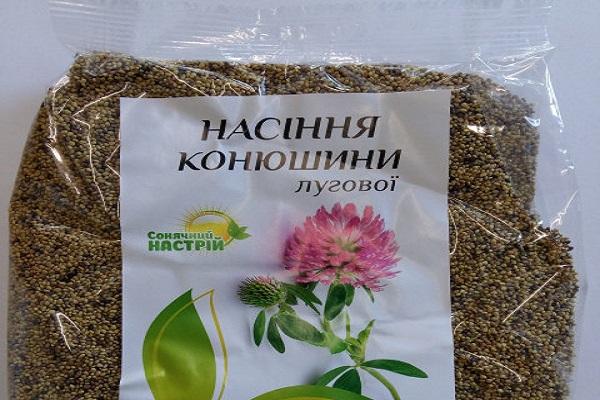

Landscape design
Trefoil decorates local areas, garden plots, create landscape design: alpine hills, colorful rocky gardens (rockeries). The varieties of meadow clover are suitable for these purposes. Several species have been bred by breeders. Designers use many varieties of plants to create ideas.
See also
Medicinal properties and contraindications of rhododendron, use in folk medicineRead
Lawn grass
Lawns are decorated mainly with creeping clover, a perennial with white flowers. They plant low-growing varieties, thick, unpretentious, which quickly rise after mowing, trampling. Clover lawns decorate the site, give an elegant, well-groomed look.


Planting clover
Clover grows in a wild state wherever possible, from this we conclude that it is very unpretentious to care and tenacious. However, if you want a smooth and healthy clover rug, it is best to choose the most suitable spot and prepare it for planting.
Clover can grow in the shade and in the sun, but subject to sufficient moisture, as it is very dependent on moisture. Loves slightly acidic and neutral soil, rich in fertilizers. Grows well after cereal predecessors. Deep plowing or digging, removing weeds is required before planting.
Clover propagates by seeds, which are sown to a depth of about 3 cm. It is recommended to collect seeds from second year plants, they are more mature and tenacious.
Reviews and advice of gardeners
From my practice: Of course, the clover grows by itself, but if you mow it three times per season, it will fade away rather quickly. The root will weaken. Clover needs to be given time for the seeds to ripen and crumble and mow afterwards. You can mow twice (at the beginning of summer and at the end), but again so that the seeds have time to ripen and crumble before the second mowing.
hFl
When I needed space for a new flower bed last spring, it turned into a real war. There is already no clover on the surface, but at a depth of half a shovel (or better to it with a pitchfork), there are BUSHES in the ground with a root of "no way" meters. It did not work out completely. In the fall, when she was planting tulips, it happened again. This spring, I plant, again I stumble upon living roots in the ground. So it will crawl out again.
Natalia Fedorovna
In my opinion, I would not use perennials in the middle of the beds. Especially alfalfa and clover. These herbs, it seems to me, are already for real agronomists. How difficult they are to start, and how difficult they are to withdraw. It would be better for perennials to allocate their piece every few years. In general, I am more for annuals. Easier and faster to change, diversify. It is more difficult to get some undesirable consequences ...
victor 3219
I also sow mustard, but I sow it in the fall after harvesting and only in those places where I am going to grow something on the trail. year. The plot where potatoes grew this year, I sow with clover and again plant potatoes there only after 2 years. (The area allows, and I have only 1.5 hundred square meters of potatoes.) As for clover, I know from my own experience that it helps to increase the yield of potatoes. I fully admit that the potato crop would have increased without clover, but only from the fact that the land would "rest" for 2 years. But the clover does not allow the harsh weeds to grow and the soil under it remains loose. These are additional advantages of clover.
vsafr
Clover is a good green manure and is exactly for two years. but my area does not allow
Viktor__s
If you have never sowed clover, then you need to know the following. In the thickets of clover, dampness is always preserved, slugs and snails are bred. It is difficult to mow it.
Shkiper50
Clover is not a siderat for every occasion. It is worth growing it in a perennial culture, and this will require a separate piece of land. Red clover gives a lot of green mass for mulching and compost, white clover is good for soil in the garden.If you need to grow green manure 2-3 weeks before the main crop or the onset of cold weather, then it is better to choose fast-growing: mustard, rapeseed, phacelia, vetch.
Clover care
Clover care will be reduced to loosening the soil, removing weeds, fertilizing with fertilizers.
Watering for clover is extremely important. All species are dependent on watering and need it. Meadow clover is very sensitive to overflows, which is negative for it. Pink refers to overflows normally, it can grow on soils with a close occurrence of groundwater. White does not react to overflows as well as meadow, but also not as neutral to them as pink. But underfilling is unfavorable for all types of clover.
Now let's deal with fertilizers:
1. In autumn, manure is introduced for digging (in the fields, it is brought under a cover crop for winter crops). The introduction of organic fertilizers in the fall, and not just before planting in the spring, has a positive effect on the yield. 2. Before planting, add phosphorus-potassium fertilizers to the soil. 3. In the case of podzolic soils, boric fertilizers are also applied, spraying the plants at the beginning of flowering.
If you want to collect clover seeds, select several large, brown heads, peel off excess husks, dry for a week in a dry, warm place without direct sunlight, after which the seeds are placed in a box for storage until planting.
Testimonials
- Vladimir, 56 years old: “My wife and I live in a private house, and from the enterprise we were given another large plot of land for a dacha outside the city. In the first years, we simply did not have time to process it, so we immediately decided to plant green manure in it, and then gradually plant different vegetables in its place. The clover grew by itself, formed such a uniform green field, and the neighbors, seeing that we were not doing anything with it, asked to mow it to make hay for their animals. After they mowed it for the fourth time this summer, the clover began to grow poorly, I read that frequent mowing leads to weakening of its roots. Therefore, in the second year on the site there were only islets of plants, and not a full field, it was necessary to plant empty spaces. "
- Nikolay, 42 years old: “After buying a house, I decided for myself that on my site there would be complete unity with nature, which means no digging up the soil, no chemicals and the like. The maximum I will walk through some places with a Fokin flat cutter, for loosening the soil and that's it. When asked how to nourish it with the necessary natural fertilizers and improve its composition, I chose green manure sowing. In this capacity, I had a red clover, in the first year I bought the seeds of its white counterpart, but then I was tortured to get rid of it in the fall: it spread all over the site, and the roots made their way deep into the ground. "
Types and varieties of clover
he has lived with us for about 200 years and with his help many new varieties have been obtained. It is this species that is used everywhere for livestock feed. It inhabits not only meadows and fields, but also mountainous regions.
Red clover (Trifolium praténse)
White clover, aka creeping (Trifolium repens)
Perennial plant about 40 cm in height with a low creeping stem, trifoliate leaves, rounded. It grows in pastures and meadows in the wild; when planted in a garden or fields, it is often used in a mixture with various types of clover and wheat. Very tenacious, endures everything: trampling, frost. The downside of this species is the rapid growth and clogging of some plants in the flower garden.




